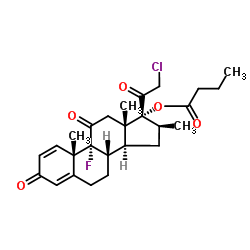Clobetasone butyrate

Clobetasone butyrate structure
|
Common Name | Clobetasone butyrate | ||
|---|---|---|---|---|
| CAS Number | 25122-57-0 | Molecular Weight | 478.981 | |
| Density | 1.3±0.1 g/cm3 | Boiling Point | 573.3±50.0 °C at 760 mmHg | |
| Molecular Formula | C26H32ClFO5 | Melting Point | 179 °C | |
| MSDS | Chinese USA | Flash Point | 181.1±19.3 °C | |
| Symbol |

GHS08 |
Signal Word | Warning | |
Use of Clobetasone butyrateClobetasone butyrate is a synthetic glucocorticoid and has topical anti-inflammatory activity especially in skin. Clobetasone butyrate can be used to relieve corticosteroid-responsive dermatoses, including atopic dermatitis and psoriasis[1]. |
| Name | Clobetasone 17-Butyrate |
|---|---|
| Synonym | More Synonyms |
| Description | Clobetasone butyrate is a synthetic glucocorticoid and has topical anti-inflammatory activity especially in skin. Clobetasone butyrate can be used to relieve corticosteroid-responsive dermatoses, including atopic dermatitis and psoriasis[1]. |
|---|---|
| Related Catalog | |
| Target |
IC50: glucocorticoid[1] |
| In Vivo | Clobetasone butyrate (application on the skin; 0.05%; 7 weeks) induces epidermal thinning in skin, Clobetasone butyrate 7 weeks causes much less epidermal thinning in the pig than flurandrenolone (0.05%) or fluocinolone acetonide (0.025%), both of which causes severe atrophy[1]. Animal Model: Large white domestic pig[1] Dosage: 0.5% application on the skin Administration: 7 weeks Result: Caused moderate to slight atrophy. |
| References |
[2]. Michael Stewart, et al. Clobetasone butyrate for inflammatory skin conditions. |
| Density | 1.3±0.1 g/cm3 |
|---|---|
| Boiling Point | 573.3±50.0 °C at 760 mmHg |
| Melting Point | 179 °C |
| Molecular Formula | C26H32ClFO5 |
| Molecular Weight | 478.981 |
| Flash Point | 181.1±19.3 °C |
| Exact Mass | 478.192230 |
| PSA | 77.51000 |
| LogP | 4.82 |
| Vapour Pressure | 0.0±1.6 mmHg at 25°C |
| Index of Refraction | 1.551 |
| Stability | Stable. Combustible. Incompatible with strong oxidizing agents. |
CHEMICAL IDENTIFICATION
HEALTH HAZARD DATAACUTE TOXICITY DATA
|
| Symbol |

GHS08 |
|---|---|
| Signal Word | Warning |
| Hazard Statements | H351 |
| Precautionary Statements | P281 |
| Personal Protective Equipment | Eyeshields;full-face particle respirator type N100 (US);Gloves;respirator cartridge type N100 (US);type P1 (EN143) respirator filter;type P3 (EN 143) respirator cartridges |
| Hazard Codes | Xn:Harmful |
| Risk Phrases | R40 |
| Safety Phrases | S22-S36 |
| RIDADR | NONH for all modes of transport |
| RTECS | TU4154083 |
|
Topical steroids for chronic wounds displaying abnormal inflammation.
Ann. R. Coll. Surg. Engl. 95(4) , 291-6, (2013) Chronic, non-healing wounds are often characterised by an excessive, and detrimental, inflammatory response. We review our experience of using a combined topical steroid, antibiotic and antifungal pre... |
|
|
[Herpes gestationis].
Acta Med. Port. 17(1) , 107-9, (2004) Herpes Gestationis is a serious dermatological disease, albeit rare, associated to pregnancy or to the trophoblast diseases. Contrary to what the name suggests, it is not a viral disease but an auto-i... |
|
|
Determination of natural and synthetic glucocorticoids in effluent of sewage treatment plants using ultrahigh performance liquid chromatography-tandem mass spectrometry.
Environ. Sci. Pollut. Res. Int. 22 , 14127-35, (2015) A sensitive and comprehensive analytical method for glucocorticoids (GCs) in water samples was developed and applied to effluent of sewage treatment plants (STPs). In the present study, totally 10 nat... |
| Kindavate |
| 21-Chloro-9-fluoro-17-hydroxy-16-methylpregna-1,4-diene-3,11,20-trione 17-butyrate |
| (16β)-21-chloro-9-fluoro-16-methyl-3,11,20-trioxopregna-1,4-dien-17-yl butanoate |
| 21-Chloro-9-fluoro-17-hydroxy-16b-methylpregna-1,4-diene-3,11,20-trione 17-Butyrate |
| MFCD00133196 |
| (16β)-21-Chloro-9-fluoro-16-methyl-3,11,20-trioxopregna-1,4-dien-17-yl butyrate |
| EINECS 246-635-9 |
| Butanoic acid, (16β)-21-chloro-9-fluoro-16-methyl-3,11,20-trioxopregna-1,4-dien-17-yl ester |
| Clobetasone butyrate |